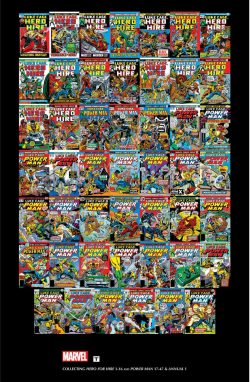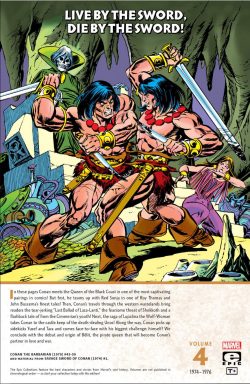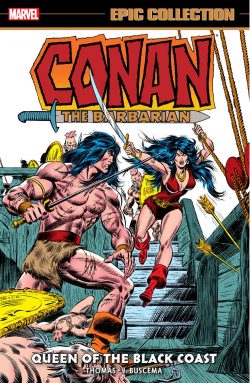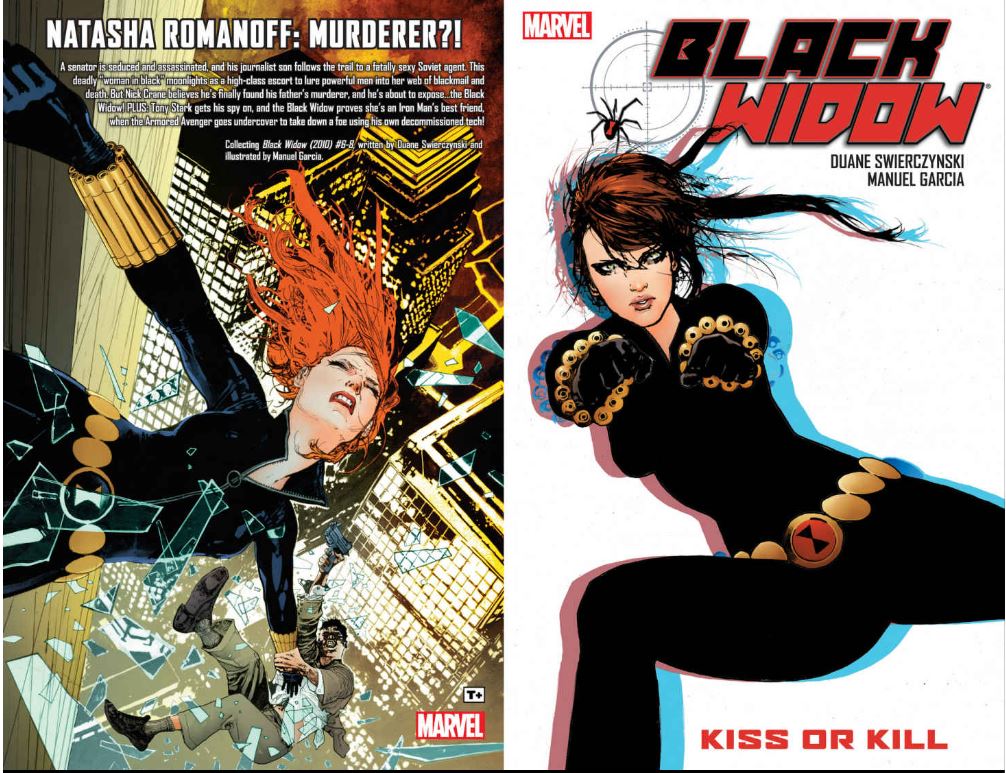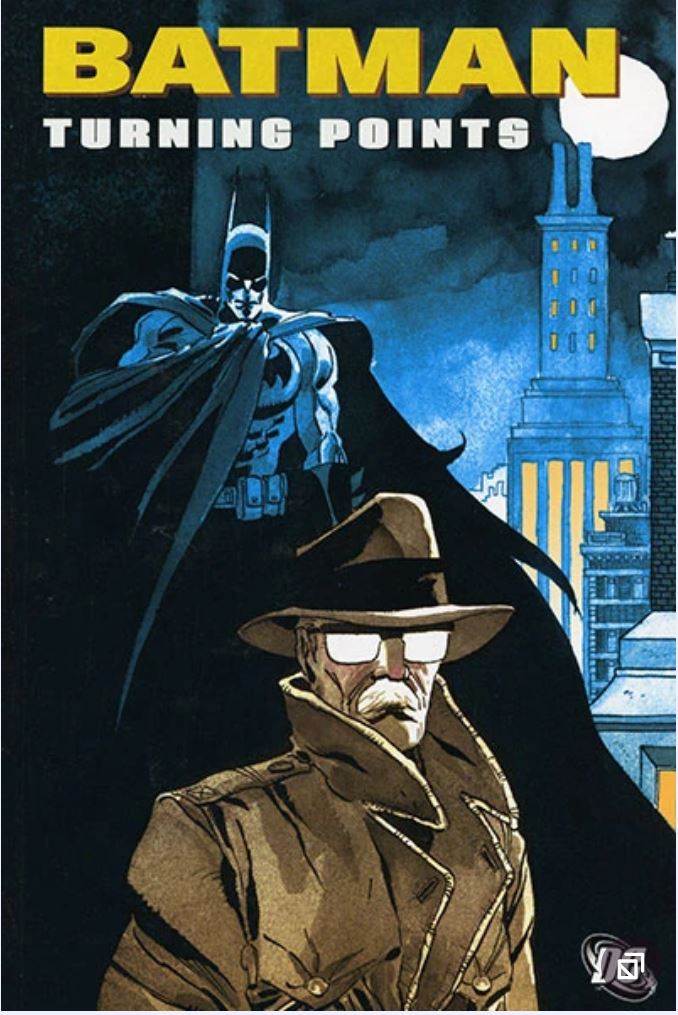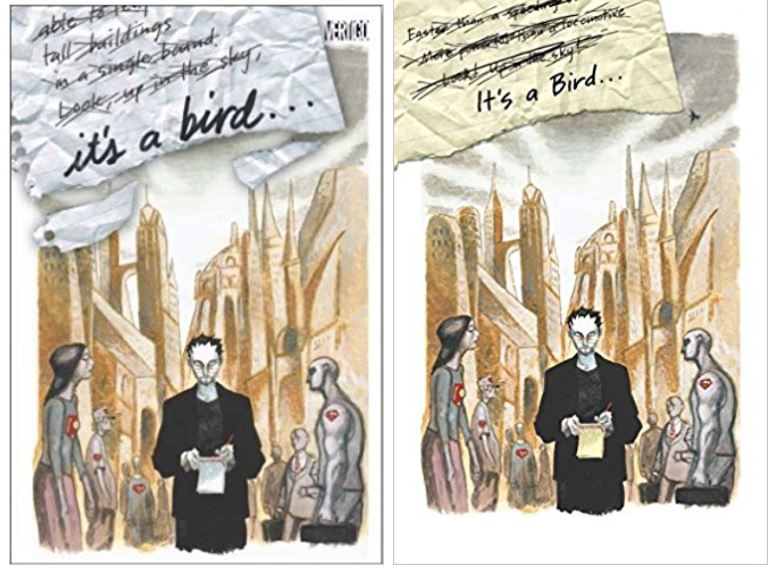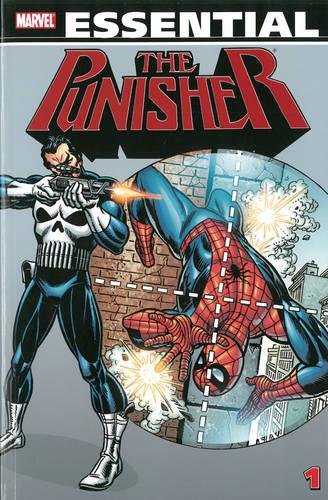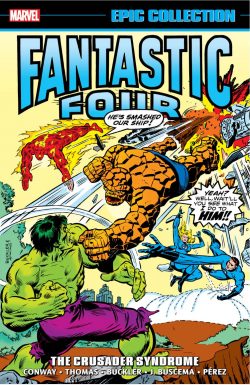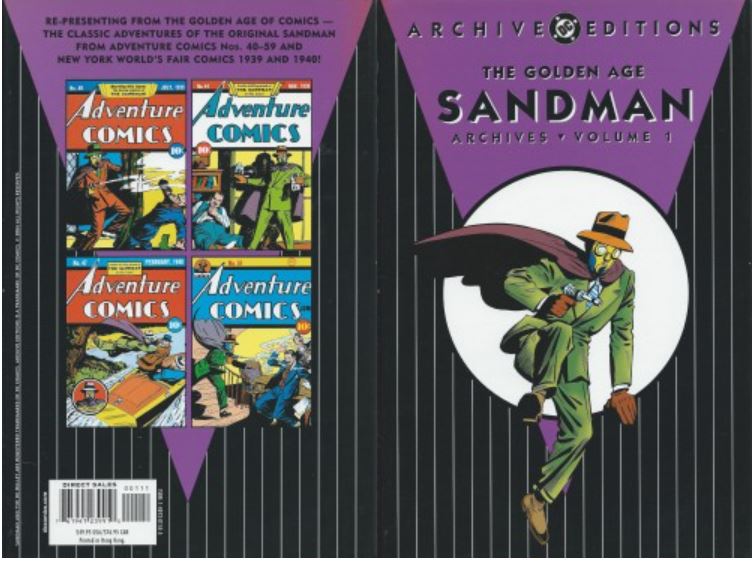
By Cary Bates, Jim Shooter, Paul Levitz, Dave Cockrum, Mike Grell, Bill Draut, Bob Wiacek, Ric Estrada & Joe Staton & various (DC Comics)
ISBN: 978-1-4012-4297-8 9 (TPB)
Once upon a time, a thousand years from now, super-powered kids from many worlds took inspiration from the greatest legend of all time and formed a club of heroes. One day those Children of Tomorrow came back in time and invited their inspiration to join them…
Thus began the vast and epic saga of the Legion of Super-Heroes, as first envisioned by writer Otto Binder & artist Al Plastino when the many-handed mob of juvenile universe-savers debuted in Adventure Comics #247 (April 1958), just as the revived superhero genre was gathering an inexorable head of steam in America. Since that time the fortunes and popularity of the Legion have perpetually waxed and waned, with their future history tweaked and overwritten, retconned and rebooted over and over again to comply with editorial diktat and popular fashion.
This sturdy, cosmically-captivating fifth massive monochrome compendium gathers the chronological parade of futuristic delights from Superboy #193, 195, and Superboy Starring the Legion of Super-Heroes #197-220, covering February 1973 to October 1976, as well as the debut issue of opportunistic spin-off Karate Kid #1 (March 1976) at a time when the superhero genre had again waned but which was slowly recovering to gain its current, seemingly unassailable ascendancy. That plunge in costumed character popularity had seen the team lose their long-held lead spot in Adventure Comics, be relegated to a back-up in Action Comics and even vanish completely for a time. Legion fans, however, are the most passionate of an already fanatical breed…
No sooner had the LSH faded than agitation to revive them began. Following a few tentative forays as an alternating back-up feature in Superboy, the game-changing and sleekly futuristic artwork of newcomer Dave Cockrum inspired a fresh influx of fans and the back-up soon took over the book – exactly as they had done in the 1960s when the Tomorrow Teens took Adventure from The Boy of Steel and made it uniquely their own…
The resurgent dramas begin here with the back-up by Cary Bates & Cockrum from Superboy #193 wherein a select team consisting of Chameleon Boy, Duo Damsel, Chemical King and Karate Kid went undercover on a distant world to prevent atomic Armageddon in ‘War Between the Nights and the Days!’ That’s followed by #195’s ‘The One-Shot Hero!’ which told the story of ERG-1 – a human converted to sentient energy in an antimatter accident. The character had been mentioned in a 1960’s tale of the Adult Legion but here Bates & Cockrum at last fleshed out his only mission and heroic sacrifice with passion and overwhelming style.
The really big change came with the July issue as the long-lived title (which had premiered in 1949 just as the Golden Age was ending) morphed into Superboy Starring the Legion of Super-Heroes with #197.
The relaunch kicked off with a full-length extravaganza. ‘Timber Wolf: Dead Hero, Live Executioner!’ saw the Boy of Steel summoned to the future to be greeted by a hero he believed had died in the line of duty. Somehow Timber Wolf had survived and triumphantly greets his old comrade, but astute Legion leader Mon-El fears some kind of trick in play. He is proved right when the miraculous survivor goes berserk at an awards ceremony, attempting to assassinate the President of Earth.
Wolf is restrained before any harm can be done and a thorough deprogramming soon gives him a clean bill of mental health. Unfortunately that’s exactly what the team’s hidden enemy had planned and when a deeper layer of brainwashing kicks in the helpless mind-slave turns off the security systems allowing militaristic alien warlord Tyr to invade Legion HQ. Happily telepathic Saturn Girl is on hand to free the mental vassal and scupper the assault, but in the scuffle Tyr’s computerised gun hand escapes, swearing vengeance…
The organisation’s greatest foes resurface with a seemingly infallible plan in #198’s ‘The Fatal Five Who Twisted Time!’ – travelling back to 1950s Smallville to plant a device to edit the next thousand years and prevent the Legion ever forming. Second chapter ‘Prisoners of the Time Lock’ reveals how a squad comprising Brainiac 5, Element Lad, Chameleon Boy, Karate Kid, Princess Projectra and Mon-El has already slipped into the relative safety of the time stream, resolved to restore history or die with a resultant clash concluding in ‘Countdown to Catastrophe’…
With an entire issue to play with but short stories still popular with readers, the format settled on alternating epics with a double-dose of vignettes. Thus issue #199 opened with ‘The Gun That Mastered Men!’ as Tyr’s computerised wonder weapon sought to liberate its creator, only to rebel at the last moment and try to take over Superboy instead. With that threat comprehensively crushed, Bouncing Boy took centre stage to relate his solo battle against Orion the Hunter in ‘The Impossible Target’ It was mere prelude to anniversary issue #200 wherein he lost his power to hyper-inflate and had to resign. However, it did allow the Bounding Bravo to propose to girlfriend Duo Damsel, unaware that she had been targeted to become ‘The Legionnaire Bride of Starfinger’. The marriage was an event tinged with grandeur and tragedy as the supervillain kidnapped her in ‘This Wife is Condemned’, attempting to emulate her powers and make an army of doppelgangers, but ‘The Secret of the Starfinger Split!’ was never revealed after Superboy enacted a cunning counter-ploy…
SsLSH #201 featured the resurrection of ERG-1 as the energy-being reconstituted himself to save the team from treachery in ‘The Betrayer From Beyond’ whilst ‘The Silent Death’ saw precognitive Dream Girl infallibly predict a comrade’s imminent demise – even though no hero anywhere appeared to be endangered. The next issue was a 100-Page Giant but only two tales were new. They were also Cockrum’s final forays in the 30th century and saw the debut of his equally impressive successor Mike Grell as inker on ‘Lost a Million Miles from Home!’ Here Colossal Boy and Shrinking Violet face a perplexing mystery in deep space: an inexplicable loss of ship’s power which compels them to abandon ship in the worst possible place imaginable. ‘Wrath of the Devil-Fish’ by Bates & Cockrum was the artist’s swan song, featuring the debut of the re-designated ERG-1 as Wildfire as an eerie amphibian creature attacked a pollution-cleansing automated Sea-Station. Of course the monster was not what he seemed and the Legion hoped they might have found a unique new recruit…
Having utterly transformed the look, feel and fortunes of the Legion, Cockrum moved to Marvel where he would perform the same service for another defunct and almost forgotten series called the X-Men…
With Grell now handling full art, the youthful Club of Champions were still on the meteoric rise, depicted as a dedicated, driven, combat force in constant, cosmos-threatening peril. However the super-science stalwarts still struggled against a real-world resurgence in spiritual soul-searching and supernatural dramas, with most of the comics industry churning out a myriad of monster and magic tales. The dominant genre even invaded the bastions of graphic futurism in #203’s ‘Massacre by Remote Control’ (Bates & Grell) when increasing indifference and neglect caused veteran legionnaire Invisible Kid to sacrifice his life to save his comrades. Sadness was tinged with arcane joy, however, as this was a twist on gothic ghost stories with the fallen hero united with a lover from the far side of the Veil of Tears…
It was back to sensibly rationalist ground for SsLSH #204 and ‘The Legionnaire Nobody Remembered’, wherein the heroes explored secrets of time traveller Anti-Lad. His accidental meddling altered history, demanding a hands-on response to fix everything, after which Bates & Grell exposed ‘Brainiac 5’s Secret Weakness!’ by reigniting his millennium-spanning romance with Supergirl. Issue #205 was another primarily-reprint 100-Page Giant which included one novel-length saga as 20th century Lana Lang saves the heroes from becoming ‘The Legion of Super-Executioners’, after the entire roster is overwhelmed by a psionic immortal patiently planning to abduct them all and breed a super-army of conquest…
‘The Legionnaires who Haunted Superboy’ led in #206 with Superboy visited by dead friends Invisible Kid and Ferro Lad. This time, the underlying theme was nascent cloning science not eldritch unrest and the outcome was mostly upbeat, after which ‘Welcome Home Daughter… Now Die!’ highlights Princess Projectra’s dilemma as both Royal champion with a commoner boyfriend and untouchable sacrosanct heir to a feudal kingdom after a dutiful family visit results in an attack by a marauding monster…
SsLSH #207 led with ‘The Rookie who Betrayed the Legion!’ as Science Police liaison Dvron seemingly colludes with mesmeric villain Universo, whilst ‘Lightning Lad’s Day of Dread!’ sees the founding hero join his wicked brother Mekt to share a moment of personal grief. It’s just a prelude to the next issue (another 100-Pager) where a 2-pronged scheme maroons Mon-El and Superboy in the 1950s whilst their comrades suffer the ‘Vengeance of the Super-Villains’ in the 30th Century. However, the cunning murder-plot of Lightning Lord’s Legion of Super-Villains is not enough to fool Brainiac 5 or wily LSH espionage chief Chameleon Boy…
In the 1960s the main architect of the Legion’s shift from quasi-comedic adventurers to gritty super-battalion was teen sensation Jim Shooter, whose scripts and layouts (generally finished and pencilled by the astoundingly talented Curt Swan) made the series irresistible to a generation of fans growing up with their heads in the Future and tension-drenched drama on their minds. Now, after time away getting a college education and working in advertising, Shooter returned in Superboy Starring the Legion of Super-Heroes #209 as ‘Who Can Save the Princess?’ tersely details how Projectra succumbs to the lethal “Pain Plague” leading her lover Karate Kid to make an ultimate sacrifice. Bates & Grell wrap up the issue with heartwarming mystery as young fan Flynt Brojj becomes a ‘Hero for a Day’; saving the Legion from an insidious assassination attempt…
SsLSH #210 was an all Shooter/Grell affair, opening with darker fare as ‘Soljer’s Private War’ reveals how a tragic victim of World War VI was transformed by horrific circumstances and resurrected to rampage unstoppably through 30th century Metropolis after which ‘The Lair of the Black Dragon’ at last unearths the incredible origin of Karate Kid. When a pack of martial artists ambush him, their defeat leads to a further attack on the aged Sensei who trained Val Armorr from infancy, and painful revelations that the Legionnaire’s birth-father was Japan’s greatest villain…
‘The Ultimate Revenge’ (scripted by Shooter in #211) sees Element Lad risk career and honour to exact vengeance on space pirate Roxxas who exterminated the hero’s entire race, whilst Bates detailed how the Legion of Substitute Heroes takes over ‘The Legion’s Lost Home’, incidentally solving one of the most infamous cold cases in the history of theft…
Shooter was now main writer and SsLSH #212 began with ‘Last Fight for a Legionnaire’ wherein a sextet of ambitious, disgruntled teens challenge Matter-Eater Lad, Saturn Girl, Cosmic Boy, Phantom Girl, Shrinking Violet and Chameleon Boy for their positions on the team – resulting in the replacement of one of veteran heroes – whilst ‘A Death Stroke at Dawn’ finds apparently ineffectual Substitute Legionnaire Night Girl regaining confidence by triumphantly saving boyfriend Cosmic Boy and herself from murderous ambushers…
In #213 Ultra Boy only realises he has a crippling psychological handicap when the hunt for infallible super-thief Benn Pares takes the team into ‘The Jaws of Fear’, after which Timber Wolf overcomes a far more physical threat with his rarely exercised wits when attacked by mega-thug Black Mace in ‘Trapped to Live – Free to Die!’ (art by Grell and inker Bill Draut).
The heroes find ‘No Price Too High’ (#214) to save a trillionaire’s obnoxious son from himself and a deranged, disaffected employee who had taken over one of his dad’s automated manufacturing worlds before Bates, Grell & Draut reveal deep-seated trauma cancelling out Shrinking Violet’s powers in ‘Stay Small – Or Die!’ Luckily for Brainiac 5, his drastic plan to shock her back to normal works in time for her to save him from the fallout of his callous actions…
Bates & Grell also observed ‘The Final Eclipse of Sun Boy’ in SsLSH #215, as an intangible assassin trails Phantom Girl to Earth and is in turn followed by an unlikely and unsuspected ally, before Shooter, Grell & Draut reveal Cosmic Boy as ‘The Hero Who Wouldn’t Fight’: honouring a sacred day of penance and superpower abstinence … even at the cost of his life.
Despite the comics world being in the grip of martial arts madness since 1973, DC were slow in making an obvious move and giving one of the oldest comic book Kung Fu fighters his own title. Karate Kid #1 (by Paul Levitz, Ric Estrada & Joe Staton) launched with a March-April 1976 cover-date, plunging valiant Val Armorr back a thousand years to contemporary New York City in ‘My World Begins in Yesterday’. The self-made warrior crashed the time barrier to recapture arch enemy Nemesis Kid, and, after rejecting friendly advice and stern orders to return to Tomorrow, tracked and trashed his enemy with the astounded assistance of schoolteacher Iris Jacobs.
Finding the primitive milieu far more amenable than his origin era, Karate Kid unexpectedly then elected to stick around in the 20th century. That same month SsLSH #216 saw Bates & Grell tackle a thorny issue in ‘The Hero who Hated the Legion’ as the team tries to recruit its first black member. Isolationist Tyroc and his entire long-sequestered race nursed a big (and perfectly understandable) grudge against modern Earth and it took determined diplomacy and a crisis threatening their entire island homeland of Marzal to confront and challenge the prejudice of centuries…
Back then, the simple fact that an African-American hero was considered sales-worthy was the biggest leap imaginable. Excluding jungle comics of the 1940s & 1950s, War comics first opened the door to black characters in the early 1960s, when Robert Kanigher & Joe Kubert created negro boxer Jackie Johnson for Sgt. Rock’s Easy Company (Our Army at War #113, cover-dated December 1961) and Marvel followed suit with a black soldier in Sgt. Fury’s Howling Commandos (Gabe Jones, debuting in #1, May 1963).
After Dell’s western gunfighter Lobo (#1-2, December 1965 & September 1966) the House of Ideas pulled far ahead in the diversity stakes by introducing America’s first negro superheroes. The Black Panther premiered in Fantastic Four #52, (July 1966) and The Falcon first fought in Captain America #117 (September 1969). Luke Cage didn’t become became the Hero for Hire until the spring of 1972, (#1, June cover-date), by which time DC had introduced August Durant/Mockingbird in Secret Six #1 (1968) and Mal Duncan in Teen Titans #26 (1970). Jack Kirby introduced Flipper-Dipper in Superman’s Pal Jimmy Olsen #133 (October 1970), New God Vykin the Black in Forever People #1 (March 1971) and many more super-characters of colour for his Fourth World Saga. He later created enterprising “ghetto kid” Shilo Norman as a hero’s apprentice and eventual successor in Mister Miracle ##15 (August, 1973): the same year Bates & Don Heck launched Nubia in Wonder Woman #206.
With more ethnic lead characters appearing, DC finally launched a black-skinned hero – John Stewart (Green Lantern #87, December 1971/January 1972) – although his designation as a “replacement” GL could be construed as more conciliatory and insulting than revolutionary. Black Lightning – DC’s first superhero in his own solo title – didn’t debut until 1977, but before that and all but forgotten now, the Legion had entered the Race race in their future chronicles…
Bates & Grell then took a peek into ‘The Private Lives of Bouncing Boy and Duo Damsel’, revealing how even retired Legionnaires still have to fight on occasion. Shooter & Grell monopolised issue #217, beginning with ‘The Charge of the Doomed Legionnaires’ wherein rapacious Khund warlord Field Marshal Lorca pits his strategic genius against Brainiac 5 but underestimates the sheer guts of his foes, whilst ‘Future Shock for Superboy’ sees the Teen of Steel beguiled by 30th century girl Laurel Kent, blithely unaware he is expressing possibly amorous interest in his own distant descendant…
Courtesy of Bates & Grell, Superboy starring the Legion of Super-Heroes #218 reveals how Tyroc’s induction into the team is shanghaied by ‘The Secret Villain the World Never Knew’ although the neophyte soon turns the tables on the interloper Zoraz, after which Shooter (with story inspiration from Ken Klaczac) discloses ‘The Plunder Ploy of the Fatal Five’ in #219 as the terrifying Fatal Five go on an implausible but ruthless spree of cosmic crimes. The Galaxy’s Most Wanted are seemingly gathering items which can only be used for the creation of an all-conquering army, but when the Legion capably counterattack, they realise they have jumped to a woefully wrong conclusion…
The comprehensive cavalcade of chronal capers concludes with #220 as inker Bob Wiacek joins Shooter & Grell for one final brace of bombastic blockbusters beginning with ‘The Super Soldiers of the Slave-Maker’. As the Legion attempts to liberate conquered planet Murgador, resistance comes from the terrified inhabitants, and the astounded saviours learn that a huge bomb at the world’s core makes them all helpless hostages to their alien overlord. The only answer is an application of subterfuge and misdirection to rectify the impossible situation before everything wraps up with ‘Dream Girl’s Living Nightmare’ as Chameleon Boy tries to cheat fate and save a cosmic benefactor from death despite infallible predictions from his precognitive comrade…
The Legion of Super-Heroes is one of the most beloved but bewildering creations in funnybook history: primarily responsible for the rapid growth of a groundswell movement that became American Comics Fandom. Moreover, these scintillating, seductively addictive stories – as much as Julie Schwartz’s Justice League or Marvel’s Fantastic Four – fuelled the interest and imaginations of generations and created the industry we know today. If you love comics and haven’t read this stuff yet, you are the poorer for it and need to feed your future dreams as soon as possible.
© 1973-1976, 2014 DC Comics. All Rights Reserved.

